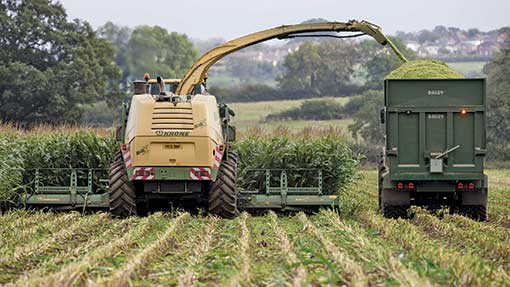Eyespot-resistance ratings make new maize list

Ratings for eyespot resistance have been included for the first time on the latest forage maize variety list, which also sees the addition of nine new first-choice varieties.
Eyespot is firmly established in the South West and crops are affected every year, but according to Agrii national maize crop manager Brendan Paul, who is also BSPB maize panel chairman, it is spreading to other regions.
“We are increasingly seeing it in South Wales, Worcestershire, Shropshire – even in parts of Cheshire as well as throughout the south-east of England,” he says. It spreads when, during rain, inoculum left over from previous crop residues splashes up on to the plant, and also by wind later on in the season.
See also: Forage maize on course for earlier harvest
Mild, wet years are eyespot years and the disease is very quick to move through the crop. It can infect the crop in early June at the six- to eight-leaf stage, but causes more damage when it comes in late to take out the top leaves, which contribute most to yield.
Later infections in cool, wet conditions in September can cause significant plant rotting and at this late stage, you can go from a good looking plant to 70-80% freshweight losses in seven to 10 days.
While there’s a range of fungicides to control the disease, Mr Paul says that it is difficult to treat and even high-clearance sprayers going through the crop at the 10- to 12-leaf stage cause damage. “It is also being exacerbated by more multiple cropping of maize and, with bad infection, crops can be written off.”
Eyespot ratings range from 3.0-7.7 on the Favourable Descriptive List, based on a 1-9 scale, with the data derived from inoculated nurseries rather than natural infection scores to provide the most reliable information.
His advice to farmers is to use the new eyespot scores as a guide in at-risk regions, but not to ignore the fungicides that are available. “We need both to ensure yields aren’t compromised.”
New varieties
The additions to the Favourable Descriptive List are DL are Asgaard, Alfastar, Emblem and Sunlite from Limagrain, Hobbit from Grainseed, Monty from DLF Trifolium, plus Sergio KWS and Exxtens from KWS and RAGT, respectively, have been added.
Sergio KWS, Emblem, Sunlite and Exxtens were also added as First Choice varieties to the Less Favourable DL, aimed at “marginal” growing conditions.
In addition to the nine new varieties, five more have been reclassified to the First Choice Favourable DL from the Second Choice list, including Ambrosini, Kontender and Salgado from KWS, plus Marco and Truxx from Grainseed and RAGT, respectively.
Niab Tag’s forage crop specialist Joanna Matthews believes that all forage maize growers will benefit from the additions.
“The new varieties offer a range of valuable characteristics within a wide range of maturity, spanning from 29.2-35.1% dry matter content on the Favourable DL.”
The additions include a cluster of potentially high-yielding varieties.
“Hobbit, Asgaard, Alfastar, Monty and Emblem offer impressive yields in excess of 18.0t DM/ha, significantly higher than the mean of the four- and five-year varieties for the respective dry matter percentage.
Dr Matthews considers Sunlite, Sergio KWS and Exxtens as well-rounded varieties.
“They combine a balance of yield with good quality characteristics, metabolisable energy levels in the range of 11.57-11.75 MJ/kg DM and starch, from 33.9-36.4% – all wrapped up in a digestible format due to the high cell wall digestibility levels from 58.1% up to 59.4%.”
Marginal areas
New additions on the Less Favourable DL offer a range of characteristics to suit growers needs.
Dr Matthews highlights Sergio KWS as a good all-round, relatively early-maturing variety combining quality with an excellent early vigour score. Early vigour is a valuable trait on less favourable sites due to the shortened growing phase.
For growers on less favourable sites, looking for highly digestible and good-quality silage, Sunlite and Exxtens may be a suitable option with ME contents of 11.59 and 11.41 MJ/kg DM, respectively, combined with a highly digestible stover at 58.7% and 58.3% cell wall digestibility, respectively.
Emblem combines high yield potential (106%) with a high starch content of 33.6%, ultimately equating to valuable high starch reserve silage.
The BSPB 2015 Forage Maize Descriptive Lists are available to download as PDFs from the BSPB and NIAB websites.
